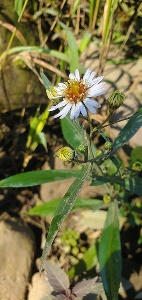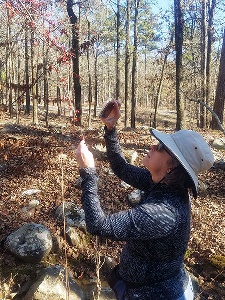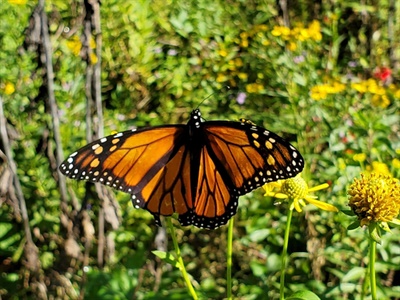On a crisp, autumn day, ANHC Botanist Diana Soteropoulos visited Cow Shoals Riverfront Forest Natural Area with ANHC Land Management Specialists Emily Roberts and John O’Dell. The first botanist to visit the site in several years and the only fall season inventory of the site, Diana anticipated adding many new taxa, a unit of rank in biology (for example, genus, species, or subspecies), to the annotated checklist of plants documented from there. The annotated checklists of plants include all the plants that have ever been seen or vouchered (dried and pressed specimen collected and deposited in an herbarium) for a natural area, and the ANHC’s botanists actively manage these lists to continuously update which plants have been found in each natural area. The Cow Shoals list Diana took with her had 124 taxa reported by previous botanists and staff. While there, she observed 191 taxa, of which 110 had not previously been recorded.
 Cow Shoals Riverfront Forest Natural Area is a 63-acre area northeast of Heber Springs and downstream of Greers Ferry Lake. The natural area is only accessible by crossing the Little Red River, which can dramatically fluctuate between a gentle mountain stream and raging white water depending on power generation from the upstream dam. Difficulty in accessing the site has resulted in few surveys.
Cow Shoals Riverfront Forest Natural Area is a 63-acre area northeast of Heber Springs and downstream of Greers Ferry Lake. The natural area is only accessible by crossing the Little Red River, which can dramatically fluctuate between a gentle mountain stream and raging white water depending on power generation from the upstream dam. Difficulty in accessing the site has resulted in few surveys.
However, a single site visit can make a big impact on knowing which taxa grow through a given season and which invasive species have taken hold. It is important to conduct plant inventory throughout the growing season and repeatedly over time to fully understand what grows where. Through the seasons, spring ephemerals will emerge and fade, replaced by summer plants, and ending with the fall flora. Along paths and roadsides, invasive species can grow and set seed, spreading into the interior of natural areas.
With 72,251 acres at 77 natural areas throughout the state, the ANHC is recruiting interested community scientists to document plants (and animals) at natural areas. The ANHC administers a project for each natural area on the iNaturalist app. These projects passively collect observations that are made within natural area boundaries, and the iNaturalist community, including experts at the ANHC, provide observation identifications.
 Almost 400 iNaturalist users have submitted nearly 12,000 observations of 2,275 species from natural areas so far. However, the number of observations among natural areas varies greatly. Five natural areas have over 500 observations each: Lorance Creek, Logoly, Pine City, Middle Fork Barrens, and Devil’s Eyebrow natural areas. On the other hand, there are 10 natural areas which have fewer than 10 observations each: Palmetto Flats, Holloway Memorial, Goose Pond, Konecny Grove, Louisiana Purchase, Cache River, St. Francis Sunken Lands, and Singer Forest natural areas.
Almost 400 iNaturalist users have submitted nearly 12,000 observations of 2,275 species from natural areas so far. However, the number of observations among natural areas varies greatly. Five natural areas have over 500 observations each: Lorance Creek, Logoly, Pine City, Middle Fork Barrens, and Devil’s Eyebrow natural areas. On the other hand, there are 10 natural areas which have fewer than 10 observations each: Palmetto Flats, Holloway Memorial, Goose Pond, Konecny Grove, Louisiana Purchase, Cache River, St. Francis Sunken Lands, and Singer Forest natural areas.
 Want to get involved? To plan a visit to a natural area, be sure to check the ANHC’s Find a Natural Area webpage for a description of the natural area, directions and where to park, whether hunting is allowed, and any site restrictions, such as privately owned or seasonally inundated areas. Details about how to navigate the ANHC iNaturalist projects can be found in the How to Use ANHC iNaturalist Projects document.
Want to get involved? To plan a visit to a natural area, be sure to check the ANHC’s Find a Natural Area webpage for a description of the natural area, directions and where to park, whether hunting is allowed, and any site restrictions, such as privately owned or seasonally inundated areas. Details about how to navigate the ANHC iNaturalist projects can be found in the How to Use ANHC iNaturalist Projects document.
Photos:
Photo 1 — Tall white aster (Symphyotrichum lanceolatum) observation from Cow Shoals Riverfront Forest Natural Area. Plant observations benefit from many detailed photographs of the top and bottom of flowers and leaves in addition to the stem and leaf attachment. Photo by Diana Soteropoulos.
Photo 2 and Main Photo — Monarch (Danaus plexippus) observation from Cow Shoals Riverfront Forest Natural Area. Photo by Emily Roberts.
Photo 3 — Community scientist, Susan Cunningham, taking photos of deciduous holly (Ilex decidua) to post to iNaturalist in January. iNaturalist observations can be made year-round. Photo by Angela Corlett, Central Arkansas Master Naturalist and ANHC herbarium volunteer.
 Cow Shoals Riverfront Forest Natural Area is a 63-acre area northeast of Heber Springs and downstream of Greers Ferry Lake. The natural area is only accessible by crossing the Little Red River, which can dramatically fluctuate between a gentle mountain stream and raging white water depending on power generation from the upstream dam. Difficulty in accessing the site has resulted in few surveys.
Cow Shoals Riverfront Forest Natural Area is a 63-acre area northeast of Heber Springs and downstream of Greers Ferry Lake. The natural area is only accessible by crossing the Little Red River, which can dramatically fluctuate between a gentle mountain stream and raging white water depending on power generation from the upstream dam. Difficulty in accessing the site has resulted in few surveys.However, a single site visit can make a big impact on knowing which taxa grow through a given season and which invasive species have taken hold. It is important to conduct plant inventory throughout the growing season and repeatedly over time to fully understand what grows where. Through the seasons, spring ephemerals will emerge and fade, replaced by summer plants, and ending with the fall flora. Along paths and roadsides, invasive species can grow and set seed, spreading into the interior of natural areas.
With 72,251 acres at 77 natural areas throughout the state, the ANHC is recruiting interested community scientists to document plants (and animals) at natural areas. The ANHC administers a project for each natural area on the iNaturalist app. These projects passively collect observations that are made within natural area boundaries, and the iNaturalist community, including experts at the ANHC, provide observation identifications.
 Almost 400 iNaturalist users have submitted nearly 12,000 observations of 2,275 species from natural areas so far. However, the number of observations among natural areas varies greatly. Five natural areas have over 500 observations each: Lorance Creek, Logoly, Pine City, Middle Fork Barrens, and Devil’s Eyebrow natural areas. On the other hand, there are 10 natural areas which have fewer than 10 observations each: Palmetto Flats, Holloway Memorial, Goose Pond, Konecny Grove, Louisiana Purchase, Cache River, St. Francis Sunken Lands, and Singer Forest natural areas.
Almost 400 iNaturalist users have submitted nearly 12,000 observations of 2,275 species from natural areas so far. However, the number of observations among natural areas varies greatly. Five natural areas have over 500 observations each: Lorance Creek, Logoly, Pine City, Middle Fork Barrens, and Devil’s Eyebrow natural areas. On the other hand, there are 10 natural areas which have fewer than 10 observations each: Palmetto Flats, Holloway Memorial, Goose Pond, Konecny Grove, Louisiana Purchase, Cache River, St. Francis Sunken Lands, and Singer Forest natural areas. Want to get involved? To plan a visit to a natural area, be sure to check the ANHC’s Find a Natural Area webpage for a description of the natural area, directions and where to park, whether hunting is allowed, and any site restrictions, such as privately owned or seasonally inundated areas. Details about how to navigate the ANHC iNaturalist projects can be found in the How to Use ANHC iNaturalist Projects document.
Want to get involved? To plan a visit to a natural area, be sure to check the ANHC’s Find a Natural Area webpage for a description of the natural area, directions and where to park, whether hunting is allowed, and any site restrictions, such as privately owned or seasonally inundated areas. Details about how to navigate the ANHC iNaturalist projects can be found in the How to Use ANHC iNaturalist Projects document.Photos:
Photo 1 — Tall white aster (Symphyotrichum lanceolatum) observation from Cow Shoals Riverfront Forest Natural Area. Plant observations benefit from many detailed photographs of the top and bottom of flowers and leaves in addition to the stem and leaf attachment. Photo by Diana Soteropoulos.
Photo 2 and Main Photo — Monarch (Danaus plexippus) observation from Cow Shoals Riverfront Forest Natural Area. Photo by Emily Roberts.
Photo 3 — Community scientist, Susan Cunningham, taking photos of deciduous holly (Ilex decidua) to post to iNaturalist in January. iNaturalist observations can be made year-round. Photo by Angela Corlett, Central Arkansas Master Naturalist and ANHC herbarium volunteer.
